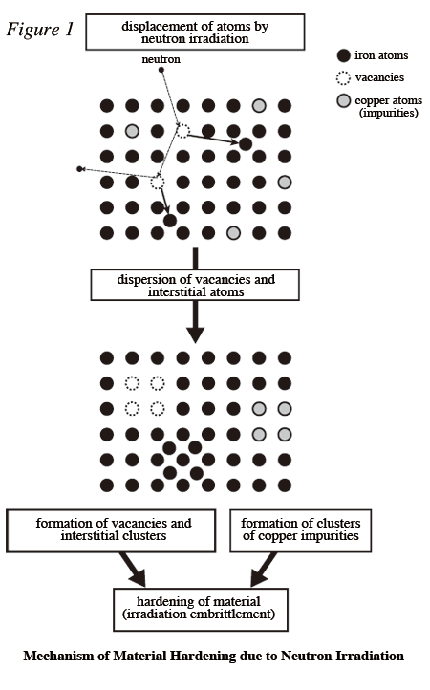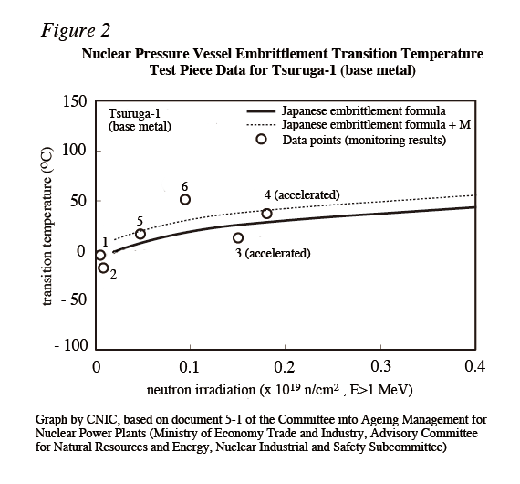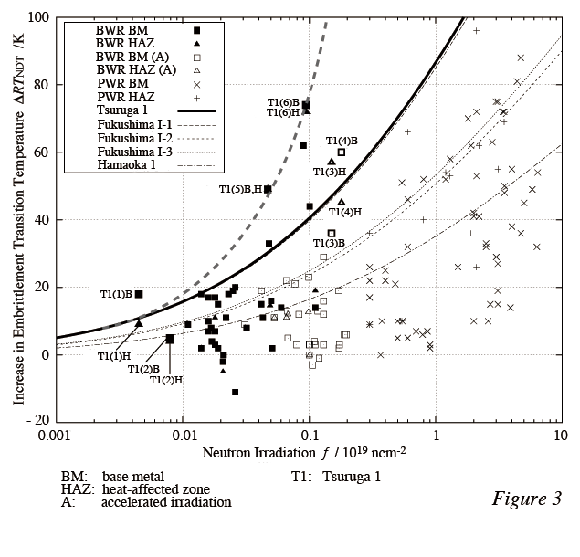The Deepening Puzzle of Steel Used in Reactor Pressure Vessels Nuke Info Tokyo No. 115
Degradation cannot be predicted
One of the most frightening type of nuclear accidents is a sudden break-up of the reactor pressure vessel as a result of embrittlement. The pressure vessel of a boiling water reactor (BWR) is between 4 and 6.5 meters wide and about 20 meters tall and is made of low-alloy steel. Like carbon steel, low alloy steel is very strong. Its main component is iron, but it also contains 0.2% carbon, 1.35% manganese, 0.66% nickel and 0.5% molybdenum. Copper is also present as an impurity. If the pressure vessel were to suddenly break up, fragments of steel would fly like missiles into the containment vessel. The containment vessel is only a few centimeters thick, so these fragments would open holes through which radioactive substances would escape from the pressure vessel to the surrounding environment. This disastrous scenario must be avoided at all costs. Consequently, people involved in the nuclear industry get nervous about the condition of pressure vessels, in particular in aging reactors.
The Japan Institute of Metals and the Iron and Steel Institute of Japan held their autumn meeting from September 16th-18th at Niigata University. One of the symposiums was about the latest research into the mechanism of embrittlement caused by irradiation of the steel in nuclear pressure vessels. It focused on prediction of microscopic embrittlement mechanisms. This article reports on a paper presented at the nuclear materials workshop by Hiromitsu Ino, Chihiro Kamisawa and Yoshinori Ito, all members of CNIC’s Citizens’ Research Group on Nuclear Power Plant Aging Issues. Their paper was entitled “Abnormal irradiation embrittlement of pressure vessel steels of domestic BWR plants”.
What is irradiation embrittlement?
 Inside the reactor core neutrons are continually inducing uranium atoms to undergo nuclear fission. Each time an atom fissions, it releases more neutrons, thus sustaining the chain reaction. Inevitably, irradiation by these neutrons is greatest in the part of the pressure vessel closest to the core. This irradiation displaces atoms in the pressure vessel from their original position. These atoms lodge between other atoms in the atomic lattice structure, while vacancies are created where these atoms originally were. If clusters of such vacancies and surplus atoms are formed, these areas become less flexible when force is applied. The material is said to have hardened (see figure 1).
Inside the reactor core neutrons are continually inducing uranium atoms to undergo nuclear fission. Each time an atom fissions, it releases more neutrons, thus sustaining the chain reaction. Inevitably, irradiation by these neutrons is greatest in the part of the pressure vessel closest to the core. This irradiation displaces atoms in the pressure vessel from their original position. These atoms lodge between other atoms in the atomic lattice structure, while vacancies are created where these atoms originally were. If clusters of such vacancies and surplus atoms are formed, these areas become less flexible when force is applied. The material is said to have hardened (see figure 1).
To say that the material has hardened means that it has become brittle. As long as the force applied is small the material is very strong, but above a certain force cracks appear. These cracks grow rapidly until the material suddenly breaks. This is embrittlement fracture. It is easy to imagine what happens by comparing it with glass and stones.
Generally materials are harder at low temperatures. However, when materials are continually irradiated with neutrons, the temperature at which embrittlement fracture occurs rises more or less proportionally to the hardening of the material. Consequently, if the pressure vessel is cooled suddenly, there is a danger that it will suddenly break up due to the heat stress which arises.
To prevent this from occurring, test pieces of material are placed in the pressure vessel for monitoring purposes. These are then removed and checked at predetermined intervals. Tests are carried out to determine whether irradiation embrittlement is proceeding at the predicted rate.
Research of Professor Ino’s team
The paper presented by Professor Ino et al. had two research objectives.
1. Analyze and evaluate the data from the test pieces monitored in BWR pressure vessels and assess the appropriateness of the irradiation embrittlement prediction formula used in Japan;
2. Focus on abnormal embrittlement in BWRs and propose that this is dependent on the rate of irradiation.
Six years ago, during the Tokai-2 court case, Ino contended that the irradiation embrittlement was related to the rate of irradiation of the pressure vessel, but his evidence was not accepted. Later, in June 2003, test pieces from Japan’s oldest reactor, Tsuruga-1 (commenced operation 1970), were removed and checked for the sixth time. It was discovered that the embrittlement transition temperature of these test pieces was much higher than predicted by the formula. The difference was not such that it could be said to be a random phenomenon, or within a reasonable margin of error. As shown in figure 2, the data from the third and forth monitoring tests were for test pieces irradiated at an accelerated rate. These were exposed to more neutrons than those from the sixth round of tests, which were exposed at a slower rate. The data from the third and forth monitoring tests match either the prediction formula, or the prediction formula with a margin added. From the diagram it can be seen that at the time of the fifth round of tests (test pieces removed in 1980) it was too early to judge whether the data matched the formula.

Ino believed that there was a problem with the official irradiation embrittlement prediction formula.
Official formula: ‘Delta T’ = (material factor) x (function of number of irradiating neutrons)
‘Delta T’ is the rise in embrittlement temperature. The material factor depends on the quantities of various elements (copper, nickel, phosphorous, silicon, etc.) in the material, and the function of the number of irradiating neutrons is determined experimentally. This formula does not include the rate of irradiation. However, if one considers the physical processes involved, one would expect the growth of clusters of vacancies and interstitial atoms and the accumulation of impurities to take time. Furthermore, the accumulation of clusters of impurities (copper impurities) should be a function of time. Ino et al. proposed that since atoms and vacancies move around, a time factor should be taken into account, not just the total irradiation.
Ino et al. carried out comprehensive studies of data from Ministry for Economy Trade and Industry reports for 2005. Figure 3 is one example. The horizontal axis shows the total neutron irradiation and the vertical axis shows ‘Delta T’ .

The diagram might be difficult to understand because of the numerous data points, but it seems clear that it can be divided into several lines and groups. Data for Pressurized Water Reactors (PWR) is also included. In the diagram, BM is an abbreviation for base metal and HAZ for heat-affected zone. In the case of Tsuruga-1, it appears that data points are located on the steeply rising curve. However, this curve does not correspond to the official prediction formula. I drew it myself from the ideas of Ino et al.. I thought it would be great if a formula producing this curve could be derived from the physical observations.
The results from the seventh round of tests will be very important. It is highly likely that the data points will be much higher than predicted by the official formula. Aging will continue under the government’s policy of extending the life of reactors to 60 years. We must seriously reconsider the safety of the pressure vessels.
Response of the Institutes
After Professor Ino’s aural presentation, there was a comment from a researcher at the Central Research Institute of Electric Power Industry (CRIEPI). He suggested that enough time has elapsed at Tsuruga-1 so that copper impurities will have no further impact and embrittlement will not progress. Professor Ino responded that this may be so, but that there have also been reports that, contrary to expectations, these impacts have not yet been fully played out. He went on to point out that the best way to answer this question would be to look at actual monitoring pieces, but the problem is that CRIEPI doesn’t publish this data. He added that it is very strange that Japanese researchers have to use test pieces from Belgium and Argentina. This last comment referred to a paper presented by researchers from the Tohoku University’s Institute for Materials Research.
At the beginning of the opening day, Naoto Sekimura of Tokyo University Engineering Department gave the keynote speech about recent developments in research in Japan and overseas on steel used in reactor pressure vessels. I listened very carefully to his speech, because he is the head of the technical assessment working group of Nuclear and Industrial Safety Agency’s (NISA) committee investigating management of aging nuclear power plants. Clearly he was aware of the research of Ino et al.. He expressed confidence in the progress of research into the tendency for copper-containing steel to be affected by the rate of neutron irradiation and in CRIEPI’s development of a mechanistic prediction method. He also referred to the International Group on Radiation Damage Mechanisms (13 countries, 70 people), which meets once every 18 months or so, and provides an international forum for discussion of leading edge research. I was very surprised to hear that it is not a public forum. Evidently the closed “nuclear club” is still alive and kicking.
The presentation by CRIEPI which followed left many questions unanswered. It related to an embrittlement prediction formula which took into account the rate of irradiation, but it didn’t address the key issues.
Besides the usual measurement method using an electron microscope, several other methods using the latest measurement techniques were presented at this symposium: for example positron annihilation, coincidence Doppler broadening, 3-dimensional atom probe, and local electrode atom probe. Thus the issue of embrittlement was extended to the nano-scale. However, it was clear that there were no arguments refuting the issues raised by Ino et al..
Furthermore, the question I have been asking for many years remained unanswered. Can monitoring small pieces provide a full understanding of the embrittlement of a huge pressure vessel? Also, listening to several presentations in which it was stated that manganese (which is not an impurity but one of the main components of the steel used in pressure vessels) is definitely connected to embrittlement, my concerns about reactor pressure vessels deepened. One can only conclude that the current situation is very dangerous.
Professor Ino included this information in evidence he presented on September 8th this year during the court case calling for termination of operation of the Hamaoka nuclear power plant. Let us hope that the judge in this case takes into account the latest research developments and hands down a better verdict than in the Tokai-2 case.
Yukio Yamaguchi (CNIC Co-Director)
